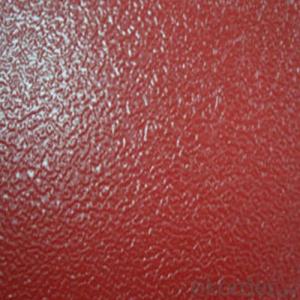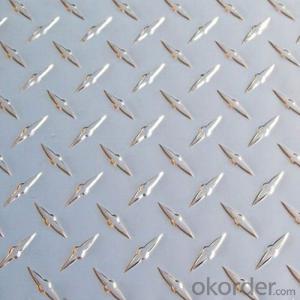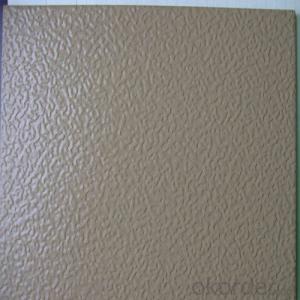Aluminium Stucco Embossed Plate for Refrigeratory
- Loading Port:
- Shanghai
- Payment Terms:
- TT OR LC
- Min Order Qty:
- 5 m.t.
- Supply Capability:
- 10000 m.t./month
OKorder Service Pledge
OKorder Financial Service
You Might Also Like
Item specifice
1.Structure of Aluminium Stucco Embossed Plate for Refrigeratory Description:
Aluminium Stucco Embossed Plates are widely used for building use, decoration use, making cookware, busing making, shipping building, airplane making and so on。Sizes of aluminum sheet for decoration use: Thickness: 0.3mm~300mm Width: Under 2000mm ( Standard: 1000mm, 1219mm, 1500mm, 1540mm) Length: Under 10000mm. Products commonly used in signs, billboards, building exterior decoration, bus body, high factory wall decoration, kitchen sink, lamp, fan, electronic components, chemical apparatus, sheet processing, deep drawing or spinning hollow ware, welding parts, heat exchangers, Bell surface and plate, plates, kitchen utensils, accessories, safety equipment and other.
2.Main Features of Aluminium Stucco Embossed Plate for Refrigeratory:
Aluminum Alloy Grade: 1050 1060 1100 3003 5052
Temper: H12, H14, H18, H22, H24, H26
Thickness: 0.8mm~5.0mm
Thickness tolerance: +/-0.01-0.04mm
3. Aluminium Stucco Embossed Plate for Refrigeratory Images:
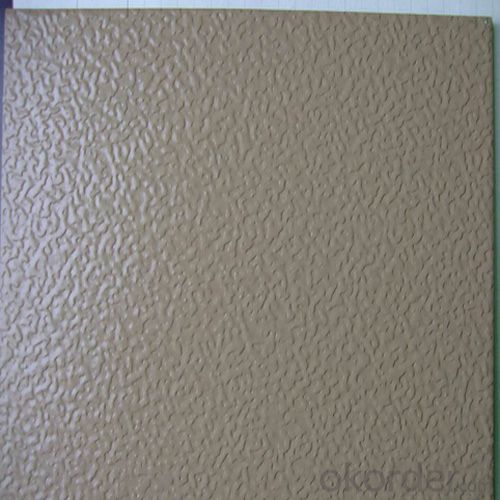
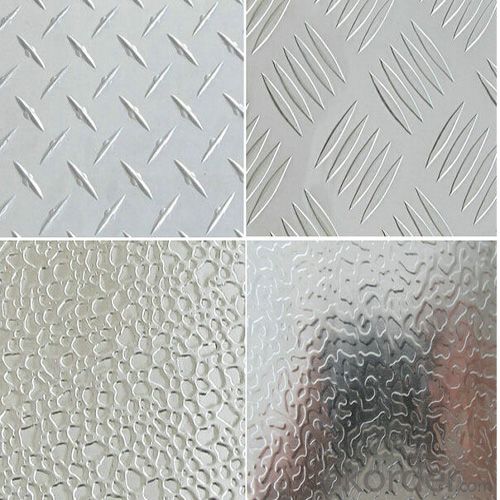

4. Aluminium Stucco Embossed Plate for Refrigeratory Specification:
| Aluminium sheet | |||||
| Alloy No. | Thickness (mm) | Width (mm) | Length (mm) | Temper | |
| A1050,A1060, A1070,A1100 | 0.2-100 | 20-2200 | 20-8000 | O,H12,H22,H14,H16,H18, H24,H26,etc | |
| 3A21,A3003,A3105,A3004 | 0.2-100 | 20-2200 | 20-8000 | O,H14,H18,H24,etc | |
| A5052 ,A5005,A5083,A5754 | 0.2-100 | 20-2200 | 20-8000 | O,H18,H24,H32,H34,H111,H112 ,etc | |
| A6061,A6082,A6063 | 0.2-200 | 20-2200 | 20-8000 | T4,T6, T651,etc | |
| A8011 | 0.2-100 | 20-2200 | 20-8000 | O,H12,H22,H14,H16,H18,H24,H26, etc | |
5.FAQ
Q1.How long have you been in this product?
A1:More than 10 years.
Q2. What's the minium quantity(MOQ)?
A2. 5 Metric tons
Q3. How long is shipping time?
A3. 7 (ready-made products)-25 days(OEM)
Q4. How do you guarantee the quality?
A4. 1. Cooperating and Exchaning experience with sevral quoted aluminum companies
2. Japanese and Swiss production line and skilled works (regular training and testing)
3. more than 10 years production experience.
Q5. Do you have after sale service?
A5. Yes. Any quality problem occurs within one year, pls take photoes,we will be responsible.
- Q:What is an aluminum sheet?
- Typically rectangular in shape and with a consistent thickness, an aluminum sheet is a flat piece of aluminum. This lightweight and versatile metal, known for its corrosion resistance and high strength-to-weight ratio, is used to create aluminum sheets. These sheets find common application in industries like construction, transportation, aerospace, and manufacturing. To meet specific requirements, they can be further processed, cut, shaped, or formed. Aluminum sheets offer a wide range of options for different uses, as they come in various grades and finishes, including smooth, brushed, and textured surfaces.
- Q:Can aluminum sheets be used for automotive heat shields?
- Yes, aluminum sheets can be used for automotive heat shields. Aluminum is a popular choice for heat shields in the automotive industry due to its excellent thermal conductivity and heat resistance properties. It has a high melting point and can effectively dissipate heat, making it suitable for protecting various components from excessive heat exposure. Additionally, aluminum sheets are lightweight and easy to shape, allowing for custom designs to fit specific automotive applications. Overall, aluminum sheets are a reliable and cost-effective option for automotive heat shields.
- Q:Can aluminum sheets be used for pharmaceutical lab equipment?
- Aluminum sheets have the capability to be utilized in pharmaceutical lab equipment. Aluminum, a versatile material, offers numerous benefits for pharmaceutical applications. Its lightweight nature, resistance to corrosion, and exceptional thermal conductivity make it an excellent option for constructing trays, shelves, and cabinets that are employed for storing and transporting pharmaceutical substances. Moreover, aluminum can be easily sterilized and cleaned, which is vital for maintaining hygienic conditions in pharmaceutical laboratories. Nevertheless, it is crucial to acknowledge that specific pharmaceutical procedures may demand materials that comply with particular regulatory standards. Thus, it is always wise to seek advice from industry experts or regulatory bodies to ensure that the selected aluminum sheets fulfill the necessary requirements for their intended usage in pharmaceutical lab equipment.
- Q:What are the different methods for bending aluminum sheets?
- There are several methods for bending aluminum sheets, depending on the desired outcome and the equipment available. Here are some common methods: 1. Manual Bending: This method involves using a manual brake or bending tool to manually bend the aluminum sheet into the desired shape. It is suitable for smaller projects and can be done by hand with the use of clamps or by using a simple bending tool. 2. Press Brake: A press brake is a machine that uses a punch and die set to bend the aluminum sheet. It applies a significant amount of force to create precise and consistent bends. Press brakes are commonly used in industrial settings and are suitable for larger-scale projects. 3. Roll Bending: Roll bending involves passing the aluminum sheet through a series of rollers to gradually bend it into the desired shape. This method is often used for long, continuous bends or curves and is commonly employed in the production of cylindrical or conical shapes. 4. Rotary Bending: Rotary bending utilizes a roller or wheel that rotates along the length of the aluminum sheet to bend it into a curve. This method is particularly useful for creating smooth, uniform bends in thin aluminum sheets. 5. Heat Bending: Heat bending involves heating the aluminum sheet to a specific temperature to make it more malleable and then bending it into the desired shape. This method is commonly used for thicker aluminum sheets or when complex shapes are required. It is important to note that the appropriate method for bending aluminum sheets depends on factors such as the thickness and alloy of the aluminum, the desired bend angle and radius, and the equipment available. It is recommended to consult with professionals or reference specific guidelines for the best results.
- Q:Are the aluminum sheets suitable for manufacturing electrical enclosures?
- Yes, aluminum sheets are suitable for manufacturing electrical enclosures. Aluminum is a lightweight, durable, and corrosion-resistant material, making it an excellent choice for enclosures that require electrical conductivity and protection. Additionally, aluminum can be easily manipulated and formed into various shapes, allowing for customization and efficient manufacturing processes.
- Q:Can 101 aluminum sheets be bonded to other materials?
- Indeed, it is possible to bond 101 aluminum sheets with other materials. Aluminum demonstrates remarkable versatility in its capability to be bonded with a vast array of substrates through diverse bonding techniques. Several commonly employed methods for bonding aluminum sheets to other materials comprise adhesive bonding, mechanical fastening, welding, and brazing. The selection of a specific bonding technique hinges upon factors such as the composition of the material to be bonded with aluminum, the desired strength of the bond, and the intended application. Nonetheless, it is crucial to ensure compatibility between the aluminum sheets and the other materials to guarantee the establishment of a robust and long-lasting bond.
- Q:Can aluminum sheets be painted or coated with different colors?
- Aluminum sheets are capable of being painted or coated in a variety of colors. The versatility of aluminum as a material makes it easy to achieve the desired aesthetic through painting or coating. To paint or coat aluminum, a layer of paint or coating material is applied onto the sheet's surface. This can be accomplished through spraying, rolling, or dipping methods. The paint or coating adheres to the aluminum, creating a protective layer while altering its color or finish. The ability to paint or coat aluminum sheets in different colors provides limitless opportunities for customization and design possibilities.
- Q:what's the difference between the knocking voice of aluminum sheet and stainless steel?
- The voice of aluminum sheet is toneless, and the voice of stanless steel is more crisp.
- Q:How do you prevent distortion of aluminum sheets during welding?
- To prevent distortion of aluminum sheets during welding, there are several key measures that can be taken: 1. Proper joint preparation: Ensuring that the edges of the aluminum sheets are properly cleaned and beveled before welding is crucial. This helps in achieving a better fit-up and minimizes the chances of distortion. 2. Fixture and clamping: Using appropriate fixtures and clamps to hold the aluminum sheets in place during welding can help to restrain and distribute the heat more evenly. This helps in reducing the risk of distortion by preventing the sheets from moving or buckling due to thermal expansion. 3. Tack welding: Prior to performing a full weld, tack welding can be done at regular intervals along the joint. This helps in temporarily fixing the sheets in place and distributing the heat, allowing for more controlled cooling and minimizing distortion. 4. Welding sequence: Applying a proper welding sequence can also help in preventing distortion. It is recommended to start welding from the center and gradually move towards the edges, alternating between sides. This helps in balancing the heat input and minimizing distortion by allowing the welded sections to cool down before the next weld is performed. 5. Preheating and post-weld heat treatment: For thicker aluminum sheets, preheating the material before welding can help to reduce the temperature gradient and minimize distortion. Additionally, post-weld heat treatment can be applied to relieve residual stresses and promote dimensional stability. 6. Welding technique: Employing appropriate welding techniques such as using a lower heat input and slower travel speed can help in minimizing distortion. Additionally, using a smaller weld bead size and avoiding excessive weaving can also help to control the heat input and reduce the chances of distortion. 7. Proper weld parameters: Ensuring that the welding parameters such as voltage, current, and wire feed speed are properly set and maintained is crucial. Using the correct parameters for the specific aluminum alloy being welded can help to achieve a more controlled heat input, minimizing distortion. By implementing these preventive measures, the risk of distortion during aluminum sheet welding can be significantly reduced, resulting in improved weld quality and dimensional stability.
- Q:What are the different methods of surface etching for aluminum sheets?
- There are several methods of surface etching for aluminum sheets, each with its own advantages and applications. Some of the most common methods include: 1. Chemical etching: This method involves using a chemical solution to selectively remove a thin layer of aluminum from the surface. The solution typically contains acids or alkaline substances that dissolve the metal, creating a textured or patterned surface. Chemical etching is precise and can achieve intricate designs, making it ideal for decorative or aesthetic purposes. 2. Mechanical etching: Also known as abrasive blasting or sanding, mechanical etching involves using abrasive materials such as sandpaper or wire brushes to physically remove the top layer of aluminum. This method is relatively simple and can be done manually or with the help of machinery. Mechanical etching is commonly used to create a uniform matte finish or to prepare the surface for further treatments, such as painting or coating. 3. Electrochemical etching: This method utilizes an electrical current to selectively dissolve the aluminum surface. The aluminum sheet is immersed in an electrolyte solution, and a direct current is applied through a stencil or mask to create the desired pattern. Electrochemical etching is commonly used for marking or labeling purposes on aluminum sheets, as it can produce clear, permanent, and highly precise designs. 4. Laser etching: Laser etching involves using a high-powered laser to remove the top layer of aluminum, creating a permanent and precise pattern on the surface. This method is highly accurate and can achieve intricate designs with sharp edges. Laser etching is commonly used for industrial applications, such as marking serial numbers, logos, or barcodes on aluminum sheets. 5. Photochemical etching: This method involves using a photosensitive material, known as a photoresist, to create a pattern on the aluminum surface. The aluminum sheet is coated with the photoresist, exposed to UV light through a stencil or mask, and then developed to remove the unexposed areas. The exposed aluminum is then etched away using a chemical solution. Photochemical etching is commonly used for producing high-resolution designs or microstructures on aluminum sheets. Each of these methods has its own advantages, depending on the desired outcome and application. It is important to consider factors such as precision, speed, cost, and complexity when choosing the appropriate surface etching method for aluminum sheets.
1. Manufacturer Overview |
|
|---|---|
| Location | |
| Year Established | |
| Annual Output Value | |
| Main Markets | |
| Company Certifications | |
2. Manufacturer Certificates |
|
|---|---|
| a) Certification Name | |
| Range | |
| Reference | |
| Validity Period | |
3. Manufacturer Capability |
|
|---|---|
| a)Trade Capacity | |
| Nearest Port | |
| Export Percentage | |
| No.of Employees in Trade Department | |
| Language Spoken: | |
| b)Factory Information | |
| Factory Size: | |
| No. of Production Lines | |
| Contract Manufacturing | |
| Product Price Range | |
Send your message to us
Aluminium Stucco Embossed Plate for Refrigeratory
- Loading Port:
- Shanghai
- Payment Terms:
- TT OR LC
- Min Order Qty:
- 5 m.t.
- Supply Capability:
- 10000 m.t./month
OKorder Service Pledge
OKorder Financial Service
Similar products
New products
Hot products
Hot Searches
Related keywords
